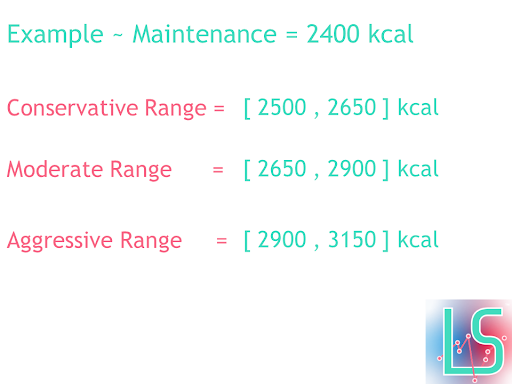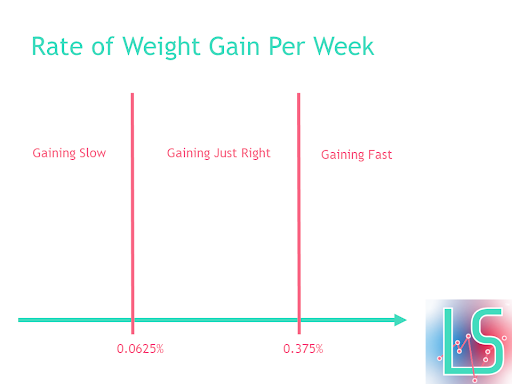An Algorithmic Approach To Bulking

“Bulking”, “Massing” and “Gaining” are all terms used to describe a period of time where an individual is purposely eating more calories (aka overfeeding) than they need to maintain their weight. This is usually done with the end goal of gaining muscle or improving sports performance because the best “gains” are typically seen in a calorie surplus. By now it is also well documented that you can only gain a finite amount of muscle over any given period of time and that excess weight gained will likely be stored as fat. This highlights the importance of having a tight control on the size of the calorie surplus when bulking because the size of the surplus directly influences the rate of weight gain.
An algorithm is a step by step solution consisting of clear instructions. Like a cooking recipe. Most people think of computers when the word algorithm is brought up, but any step by step procedure is an algorithm. The process of determining the size of an individual's calorie surplus when they are bulking can also be described as an algorithm.
The goal of this article is to describe a simple algorithm that can be used to help individuals find a calorie surplus that mitigates the risk of them gaining weight too fast or too slow. I’ll refer to the algorithm as the bulking algorithm for the rest of the article.
Before laying out the bulking algorithm, I am going to make some basic assumptions. The first is that the individual is consuming an adequate amount of protein to promote muscle growth. The second is that the individual is regularly resistance training with sufficient volume, frequency and intensity to promote hypertrophy. Lastly, we will assume that the individual already knows their maintenance calories which is the number of calories they require per day to maintain their weight aka their total daily energy expenditure (TDEE). How to satisfy these assumptions is outside the scope of the article.
Here is a flowchart describing the bulking algorithm. Below the flowchart I go into detail about how each step of the algorithm works.

1. Determining Initial Surplus
When determining the size of the calorie surplus, individuals can make one of two mistakes when deciding how many calories to eat.
1) Their surplus is too big and they put on too much fat relative to the amount of muscle they have gained.
2) Their surplus is too small or nonexistent and they are stuck spinning their wheels trying to ‘lean bulk’.
I’ve personally made both of these mistakes. When I first started lifting, I gained 50 lbs in just under 18 months. Every day I would lift as much as I could and eat as much as I could. I got a lot stronger and gained some quality muscle, but I also got way fatter than I wanted to. This is often referred to as a “dreamer bulk” or “dirty bulk”. This is a perfect example of mistake number 1 where my surplus was too large. The reason you don’t want to do this if your goal is to improve your body composition is because you are going to have a really long diet ahead of you after your bulk to lose all of the excess fat you gained.

My dreamer bulk spanned from the end of my sophomore year of highschool to the middle of my senior year of highschool. Once I got to college, I decided I wanted to get lean. I dieted aggressively and got the leanest I had ever been. When it was time to start bulking again, I was deathly afraid of putting on excess fat like I did during my last bulk. I made mistake number 2 and spun my wheels for a few months. I stayed lean, but I missed the mark when it came to bulking because I didn’t gain any significant amount of muscle.

An ideal surplus does not look like either situation I just described. The surplus should be large enough that you are gaining weight, but not so large that you gain weight too fast. Individuals that have been resistance training longer are recommended to have a smaller surplus while individuals who are newer to resistance training can have a larger surplus.
Instead of suggesting a single value for daily calorie intake, I will suggest a calorie intake range. I have laid out three different surplus range sizes along with recommendations for choosing a surplus range. Deciding which end of the range is appropriate is based upon a variety of factors including training level, goals, personal preferences and inter-individual responses to a hypercaloric diet. A range offers more flexibility and reduces the stress of having to hit a single calorie target.
| Approach | Surplus | Description |
|---|---|---|
| Conservative | 100 - 250 kcal | Choose this option if you want to gain very slowly, are somewhat lean, have 5+ years of training experience, and want to be in surplus for a long period. |
| Moderate | 250 - 500 kcal | Choose this option if you want to gain slowly, and are fairly lean, and have 3+ years of training experience. *Use this option if you are unsure* |
| Aggressive | 500 - 750 kcal | Choose this option if you want to gain quickly, are fairly lean, and are new to training. |
Once the surplus range size has been chosen, you can determine your goal daily calorie intake range by adding the lower and upper end of the range to the individual’s maintenance calories. The result is a range that looks like the following: [ Maintenance Kcal + lower end of range , Maintenance Kcal + higher end of range ].

This will be the range the individual should eat within at the start of their bulk. In the next section, I will explain when and how to change the size of the surplus range if it is necessary. You can use the form below to calculate your suggested bulking intake ranges.
2. Adjust Surplus Based On Rate Of Weight Gain
Before making any changes to the current surplus, the individual should eat within the calculated goal calorie intake range for 2 weeks. This is because 2 weeks worth of data is considered the gold standard for determining maintenance calories and gives us a sufficient amount of data to perform an analysis.
To check if the surplus is too large or too small, we will look at the rate of weight gain per week. The idea here is that if the surplus is too large, they will be gaining too fast and be at risk of putting on excess fat or if their surplus is too small, they will be gaining too slow and risk spinning their wheels without putting on much muscle.
The scientific literature suggests that from 0.25% to 1.5% of total body weight gain per month is optimal depending on the individual’s training status which equates to 0.0625% to 0.375% weight gain per week.

If an individual's rate of weight gain is within the range that is considered optimal then their goal calorie intake range should stay the same. If their rate of weight gain is less than 0.0625% they will want to add calories to the upper and lower end of the goal range because they are gaining too slow. If their rate of weight gain is greater than 0.375% then they should subtract calories from the upper and lower end of the goal range because they are gaining too fast.
Every two weeks, the rate of weight gain should be checked and the goal intake should be adjusted if the bulk is going to continue and if an adjustment is necessary. In the next section I will describe the last part of the algorithm which is how to decide if the individual should still be bulking or not. If you know your starting weight for your bulk, your current weight and how long you've been bulking, then you can use the form below to see if your current rate of weight gain per week is considered slow, fast or optimal.
3. How To Tell If The Bulk Should End
This is the hardest part of the algorithm to lay out because it ultimately comes down to subjective variables. There is limited data to guide us and most exercise science/nutrition studies only last 6-12 weeks. I recommend taking a path for at least 12 weeks if bulking. Below are some things you can check to determine if the bulk should continue.
The individual should stop bulking if they are much fatter than they would like to be and are uncomfortable with their current body composition, their bulk is starting to have significant negative impacts on their health or sports performance or they no longer satisfy the assumptions listed at the start of the article.
The individual can continue bulking if they are still relatively lean and feel comfortable with getting bigger in pursuit of more muscle, they are not experiencing significant health or sports performance side effects and they still satisfy the assumptions listed at the start of the article.
I didn't make a form for this part because it is just a checklist. It is also subjective and you may consider other variables than the ones I mentioned as general guidelines.
Conclusion
The bulking algorithm described is an effective solution to determining whether or not someone's bulk is on track for success. I have run this algorithm myself multiple times and seen great results. I am currently the biggest and leanest I have ever been as a result.
It’s also worth mentioning, this is a lot of work to do yourself. Running this algorithm by hand or mentally can be monotonous. If you are interested in bulking following this algorithm and without doing all the calculations yourself, you should check out my company LogSmarter™ LLC. Our nutrition tracking software uses machine learning and some other important optimizations that I have intentionally left out of this article to improve upon the basic algorithm I just described and has support for fat loss and weight maintenance.